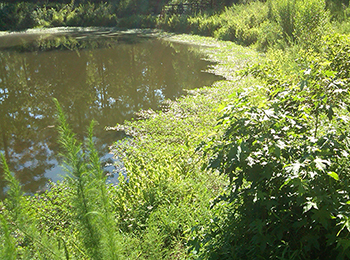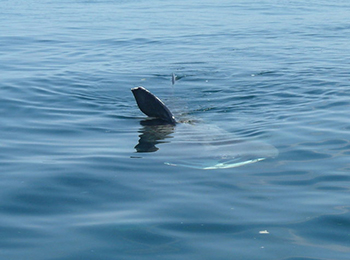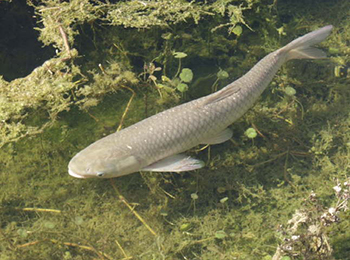The Monsters that Threatened to Take over Discovery Lake
The Monsters that Threatened to Take over Discovery Lake
By Site Ecology Team (SET) and Wildlife and Industry Together (WAIT)
June 17, 2015

It all began back in 2010, when the muddy sediment ooze of Discovery Lake gave forth what would quickly become the scourge of our campus centerpiece. It wasn’t restricted to just our side but extended all around the lake circumference.
The resident Lake Committee was called into emergency session to figure out what it was and what could be done before the lake disappeared. It looked like the creature from the ooze was growing fast enough to consume all the shoreline in short order. The Canada Geese (CG) were outraged and became very vocal, crying fowl. “How could an environmental institute allow this to happen?” came the honks. The Committee had to decide on a plan of action that was both safe to human health and the surrounding environment, and to do it quickly. A course of action began after it was determined that this invader was an invasive species going by the name Ludwigia, or Water-primrose.
After ruling out explosives and flame-throwers, the Committee turned to evaluating a chemical approach but was limited by the regulations on the use of pesticides within 30 feet of the water’s edge. No one was too keen about manual labor and physically pulling the weed out. Plus, there was the problem of spreading this invasive species even further due to its ability to regenerate from the broken stems and residual rhizomes that would result from mechanical removal.

It was about this time that Gordon contacted Mr. Carp of story-book fame. His suggestion was, you guessed it, triploid grass carp. He had but one warning: Don’t feed them too much for they grow fast. Grass carp -- a species of Asian carp introduced into the United States in 1963 for aquatic weed control -- are said to “breed like mosquitoes and eat like hogs, growing to 18 inches in six months, and more than four feet and 80 pounds in a few years.” [First evidence of grass carp reproduction found in Great Lakes] They are not ornamental carp, rather a drab silver color, with a cylindrical body and large scales.
The Committee chose to give the carp a try, since demise of the original generation of carp seems associated with Ludwigia’s arrival. It was calculated that, based on the weed type, its density, and current lake surface coverage (>10 feet out), that approximately 150 carp, 10-12” long (5-6 per acre) were needed to knock down the rapidly growing weed in the first year. Therefore, 50 carp were added to the lake in March of 2012, and another 100 carp in May. We avoided having to get a Liberation Permit from the State of North Carolina since our total introduction didn’t exceed 150 fish.

Only infertile grass carp (triploid - in that they have three sets of chromosomes) are permitted for aquatic weed control. Three sets of chromosomes don’t allow proper alignment when the gametes are formed. Therefore, there is a biological control built into each fish that prevents reproduction and population growth, which could lead to overharvesting of aquatic plants.
Since 2012, our Carp have grown to enormous size, some exceeding 30” in length. Schools of 15 plus have been observed. Even the turtles are giving them a wide berth. Most of the turtles are herbivores so some competition is to be expected. As seen in the photograph, their large size makes them a handful, and they reportedly have a muddy taste, so leave both in the lake.
Restocking will depend on how well the remaining carp control any yearly regrowth. Restocking usually is not considered until 5-6 years have elapsed. So for now, one monster is trying to keep another one in check.



